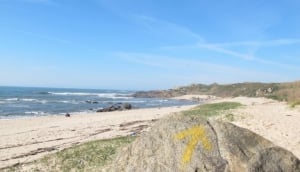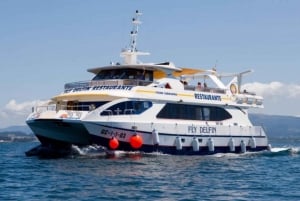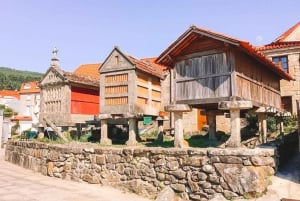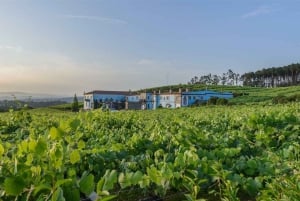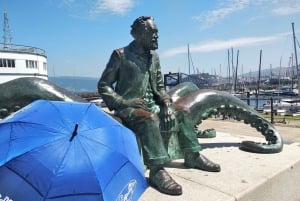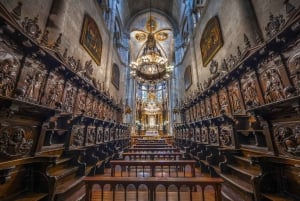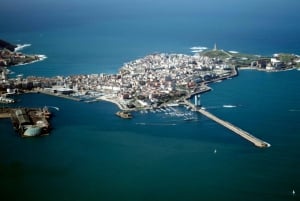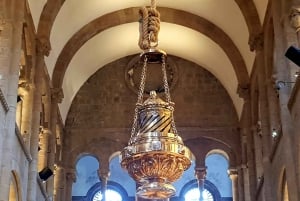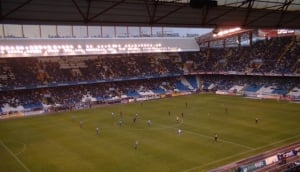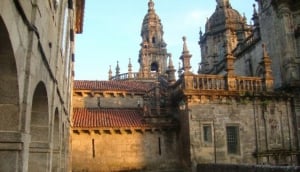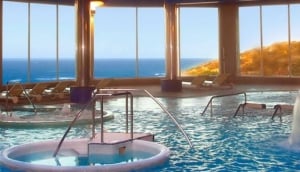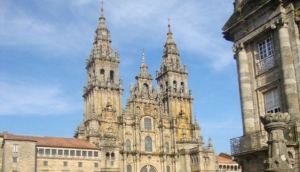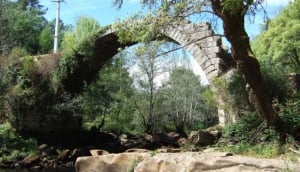The Portuguese Coastal Way from Porto to Santiago
...climbing to a vantage point where I enjoy the best coastal views I have seen...
Book Top Experiences and Tours in Galicia:
If youʻre booking your trip to Galicia last minute, we have you covered. Below are some of the top tours and experiences!- From Santiago de Compostela: La Coruña and Betanzos
- Santiago de Compostela: Private Walking Tour
- Santiago: Cathedral & Museum Tour & Pórtico of Glory Option
- Vigo: Private Walking Tour with local guide
- From Santiago: Ribeira Sacra Tour & Boat Trip
The Portuguese Coastal Way is a stunning alternative route of the Portuguese Camino de Santiago so most of my account concentrates on my coastal experiences. Following the Atlantic Coast towards Santiago de Compostela, the Portuguese Coastal Way starts in the colourful UNESCO World Heritage City of Porto. It takes me past charming seaside towns and villages along the coast of Northern Portugal before crossing by ferry to A Guarda, in Galicia, and the beautiful coastline of the Rías Baixas. It then reconnects with the official route at Redondela. I was able to discover the wild Atlantic beauty and sandy beaches of Northern Portugal and Galicia, tasting delicious seafood and wine, staying in fishing villages and writing and recording my experiences on the way. I thank in particular CaminoWays.com for collaborating with me and without their financial support it would not have been possible to write this or take the video of the Camino. I dedicate my Camino to the Blogger Luis Freixo the leading expert on this route and all the Portuguese caminos! His maps,advice, general support and company along with his wife Christine were invaluable.
The route is without any signage for significant parts and sometimes it follows the official route of the Caminho da Costa. It is a more quiet than other caminos and is a beautiful route for people to enjoy a landscape of beaches and dunes; being flat from the Porto to Caminha, although sometimes it presents difficulties in passing a few points, sometimes I was forced down onto the beach (hopefully at Low Tide) sometimes I had to look for a hidden bridge which can be inaccessible. In the vicinity of Porto the wooden walkways between the dunes are almost continuous so I walked close to the seashore for many kilometres.
My Camino starts in Porto, with its Old Town worthy of its world heritage status,its picturesque riverfront and home to Port wine. Porto is superbly located close to the Atlantic Ocean and overlooking the River Douro. It is one of the most ancient cities in Europe and its Old Town was born and developed from the Northern bank of the river during the Middle Ages – Ribeira do Porto. Porto's architectural heritage is renowned. Porto is a cultural centre, a creative and contemporary city full of museums, monuments, restaurants, bars and thriving shopping areas. The Music House, National Theatre, Palace of Bolsa, D.Luis Bridge,Medieval tower and the Cathedral are particularly worth visiting. It is also famous throughout the world for its Port wines and a visit to one of the cellars is essential , many of which are clustered close to the River Douro.
I start my Camino at the top of D.Luis Bridge and head towards the Cathedral where I pick up my first Yellow Arrow then I head out following the River Douro towards the sea. However,you can take the Metro to Matosinhos if you want to avoid the outskirts of Porto and you reach close to the coast where you get off at the 'Mercado' stop. I cross the Iron Bridge and head left where the Yellow Arrow indicates and before I know it I reach the coastline and miles of golden sandy beaches.
The Camino is flat and easy walking as I continue north close to the sea and beaches sometimes on the cycle-track or wooden walkways. I meet the occasional pilgrim as I pass a small pretty,chapel Capela de Boa Nova then an obelisk sculpture as well as numerous beach side bars,cafeterias etc and Blue Flag beaches until I arrive at Angeiras. Here I pause to watch the fisherman repairing their nets and boats and talk about what they have caught. There is also a row of charming old cottages and Sea House Museum with interpretation board in English, a feature of the Portuguese coast. Then not too long after crossing a small quaint bridge over the River Onda I see a yellow arrow painted on large granite rock pointing ahead to the Castro of Sampaio. After climbing up to a lookout point I admire the views and where I have traveled before heading down on a wooden walkway past a small beach with curious rock formations caused by centuries of the sea pounding the coast. I then pass a small bar Rumoceano at Vila Cha with pirate statue outside a good place to stop to enjoy the local cuisine. Then the next highlight is passing through Mindelo Bird Reserve with it large expanse of sand dunes and beaches interspersed with woodland.
Eventually I reach the banks of the River Axe, cross the bridge and admire at the entrance to the charming town of Vila do Conde the enormous splendor of the Monastery of Santa Clara to the right.Vila do Conde is an ancient medieval shipyard full of historical and architectural interests whose origins go back to the year 953. The Monastery of Santa Clara which was built in 1318, Matriz Church from the 16th century, the Roman Aqueduct, River Ave and the Fortress are all worth seeing. I follow the river out to sea passing the fortress pausing to admire again the views of the Monastery, town and sea before heading towards the next town, Pozoa de Varzim which merges with Vila do Conde.
Pozoa de Varzim is a popular resort for the Portuguese and many people especially from Porto have holiday homes in the area. As well as resting on the long stretches of beaches, the fort close to the casino is worth a visit.
I continue to head north along the coast in the direction Esposende. I cross the Coastal Natural Park, Parque Natural do Litoral Norte. I pass lots of agricultural land and glasshouses as well as Estela Golf Course. I then pass the attractive windmills at Apulia set into the dunes. Not long after on my left there is a row of beach-side restaurants One of these Restaurante A Cabana, a family run business who recently celebrated their 30th anniversary, is reputed to be in the Top 50 Portuguese restaurants. They have grilled seafood and local meats which are outstanding and a feature of the food on the Camino is its amazing value for money! I have a skewed squid kebab with green peppers and a jug of vinho verde white wine,it was absolutely delicious! Then after leaving Apulia behind I travel through a beautiful pine forest before arriving at the pretty village of Fao where I first see a spectacular bridge over the River Cávado.
After crossing this with care I approach Esposende another resort town popular with the Portuguese facing the Atlantic Ocean with kilometres of golden, sandy deserted beaches interspersed with lush, green pine forests. It is an old fishing village with a great setting on the estuary of the River Cavado.
After walking along the cycle-track passing the Lighthouse I am soon alone again and have left the town behind as I continue to hug the coast as I travel north. I pass close to the beautiful and wild Belinho Beach. Eventually for the first time I start to head inland and start a climb next to a river gorge until I reach a village and where there is a small vineyard. I start to drop to cross the river via an attractive stone bridge called Ponte Sebastaio, admiring the views and the peace of the place. Then I turn left and start to climb passing a series of villages as I head to the beach-side resort of Amorosa, an ideal place to take refreshment from the numerous bars etc
I look for a wooden walkway which takes me close to the sea with amazing views of wild beaches and dune systems. I then follow a footpath among the dunes which goes through the heart of the Coastal Natural Park before eventually passing a beach-side car park to the right. Out of curiosity I turn left and go along the wooden walkway until climbing to a vantage point where I enjoy the best coastal views I have seen in the whole of Northern Portugal! To the north towards Viana do Castelo, the nearest beach, Rodanho Beach, the wild open Atlantic Ocean and to the south the Camino I have just walked!
My next highlight was seeing Eifell's old iron bridge over the River Limia with amazing views of Viana do Castelo,the Basílica de Santa Luzía on the hillside in the distance,the sea and river estuary to my left and mountains to my right. I crossed the bridge then headed left for the banks of the River Limia where I reach some gardens next to Alameda 5 de Outubro.Curious as ever I turn away from the river in the direction of the Old Town of Viana do Castelo which is worth exploring, much of it pedestrianized or with one-way traffic.
Viana do Castelo is located on the north bank of the Lima estuary and is famous for its handicrafts and local costumes. The Sanctuary of Santa Luzia is particularly worth visiting by taking the funicular with commanding views of the town, the river and the Atlantic Ocean. I venture up to the Tower which is a feat in itself and marvel and one of the best views on the whole west Atlantic coast! The Republic Square, 25 April Monument and promenade are also popular attractions.
I leave the town energised by the place passing the attractive fort and soon reach another small windmill. I turn back one final time to see Viana in the distance against a mountain backdrop. Over 2 million years ago the sea had reached the foot of the mountains at Viana so has retreated alot since. I continue to follow the coast closely and then I head towards a small hill in the distance which I climb stopping to see the quaint windmills at Montedor and an old woman tending her goats. I enjoy the camino as I head through woodland which at times runs close to the sea, not a soul in sight apart form the occasional bird song,so I am left alone with the world!
I reach a restaurant car park where I start to walk along the most spectacular of all wooden walkways on this camino which is about 1.3km long. The elevated walk takes me above the remarkably high sand dunes, Praia da Ancora and canopy of the coastal forest with 360 views. I can start to appreciate Monte Santa Tecla and the Galician mountains ahead. The walkway is prone to coastal erosion so if it is closed you can backtrack and head inland to pick up the main road leading into Ancora. This is a good place to stop for some refreshments with a range of good restaurants and bars popular with day-trippers.
After passing more features including the fort,a chapel and cross I reach Playa de Moledo. This is another outstanding Blue Flag beach, a feature of the whole Portuguese coast! I then proceed straight ahead and enter via a forest track some dense woodland. I eventually rejoin a lane and head straight ahead to the banks of the River Miño and again admire the views with the town of Caminha in the distance.
Caminha is is close to the Spanish/Galician border and is an ancient fortress town overlooking the River Miño but close to the beaches of the Atlantic Ocean. The town has an attractive historical core and I pause at Matriz Church close to where I need to catch the ferry. If the ferry is closed ask at the tourist office for alternative boat services or you can carry on up river to Vila Nova de Cerveira where you cross the bridge and head towards A Guarda, adding another day to your camino!
After getting off the amazing ferry ride I head left along the river as it enters the sea passing another beautiful beach at Camposancos and a hotel,El Molino where I admire the stunning views from its bar terrace. I arrive in the Port of A Guarda.
A Guarda is exceptionally located at the mouth of the River Miño, facing the Atlantic Ocean the most southerly resort in Galicia next to the Portuguese border. It’s a fisherman’s port famous for its superb shellfish including lobsters. It is easy to find a cheap, delightful meal usually caught from the sea the very same morning! There are some excellent local beaches close to the sea and river including Playa Area Grande on the edge of town which I pass. It’s very famous for the extensive and well conserved remains of a pre-historic, fortified Celtic hill settlement (Santa Tecla) situated high up above the town in the wooded Monte Santa Tecla which was only discovered in 1913! The Celta as its known probably originates from about 500 years BC and there are remnants of over a 100 huts inside an encircling wall. Some have been fully restored with thatched roofs. There is also a stone circle, a church and Celtic museum. The views from the top in every direction either looking at the Atlantic Ocean or inland towards Portugal and the Miño river valley are out of this world and admiring the sunsets from here is one of the wonders of Galicia (like me you may wish to take a short taxi ride to get there to rest your feet!)
My camino continues north close to the coast often on the cycle-track which was recently completed which runs as far as the edge of Vigo. I enjoy the seaviews as well as the mountains which rise out of the sea. I reach a narrow main street in the charming and historic,fishing Port of Oia passing a Casa Rural, a small rural hotel, Casa Puertas on my right and shortly after also on my right the excellent seafood restaurant, Casa Henriqueta. Then after passing another excellent restaurant, A Camboa on the left I have a spectacular view ahead of the 12th century,Monastery of Oia. There is a small tourist office on the right and a great fisherman’s bar, Cafe Bar Puerto. You can visit the exterior of the Monastery but it is redundant so is not open to the public although in summer there are occasional guided visits organised by the tourist office. Next to the Cross at the entrance to the Old Town which is close to the tourist office I take the road below the giant seawall to leave the village.
After passing some isolated restaurants and hotels, I reach the small Port of Mougas which is a popular spot for surfers as well as the locals searching for mussels. I stop for refreshment at the Albergue, Aguncheiro which has a restaurant in the summer only as well as bar admiring the views. I then pass some more isolated restaurants, hotels and two campsites next to the main road to Baiona and just before the luxury hotel Talaso Atlantico famous for its seawater spa, I turn right and head up a mountain track between houses. As I climb I enjoy the views including of the Ligthhouse at Cabo Silliero. I reach the top and then start to drop towards the village of Baredo passing dense woodland.
Then after climbing out of the village along a nice, country lane I start to see Baiona. Baiona is the most touristic sea side town in the south of Galicia with a well preserved Old Town,a wide variety of important monuments,places to visit as well as its golden sandy beaches and a cycle-track which you can follow as far south as A Guarda and to the north as far as the edge of Vigo. It can get really busy in late July and August so if you like lots of atmosphere and want to experience the nightlife you won't be disappointed. It was on 1 March 1493 that the ship Carabela La Pinta arrived in the Port of Baiona with news of the discovery of America and you can visit a replica of the ship moored in the harbour which is now a Museum. Other highlights include the fortress which dates back to 1337 within which houses the Parador, at its entrance there is a Tourist Office where you can get local tourist information in English. The grounds of the Parador or the seaside walkway are great places to admire the views of the Bay of Baiona, the Cies Islands,the backdrop of the mountains and amazing sunsets. In summer between June and the end of September you can catch the ferry during the day to the Cies Islands, arguably Spain's most important National Park. You buy tickets from a modern building which is also has a cafeteria where the boats depart at the end at of the Port. Other places worth seeing include the old convent at the entrance to Rua Ventura Misa, Pazo Mendoza for a drink in its outdoor terrace watching the world go by, the two churches in Santa Liberata and Santísima Trinidad Cross.
From the centre of the Old Town I follow the yellow arrows passing a nice fountain called Fuente del Pombal before I arrive at the medieval bridge at Ramallosa. Alternatively you can continue to follow the cycle-track out of Baiona with amazing views as it hugs the bay as far as the bridge. After crossing the bridge I then turn left following the green arrow along the coastline towards Nigran. I head towards the long, golden sandy beach at Playa América (America Beach). This really is a spectacular beach one of the best in the Rias Baixas which extends for 2.6 km and you can marvel at the wonderful Atlantic Ocean and Cies Islands. I stop in Nigran where there are lots of restaurants,bars and shops. I also visit the striking church,Templo Votivo Panxón,built in the 1930's thanks to the local architect Antonio Palacios, the spire I noticed earlier from far away . I pass another amazing beach at Patos popular with surfers. The camino has become more urbanised since Baiona so I continue in between the villas and chalets crossing the beautiful Playa de Portiño as I head towards Vigo. After keeping to the cycle-track I take a lane on the left which eventually arrives at a small beach at Canido. This is where I pick up the maritime walkway and continue to follow the coastline. The character becomes more urban and I cross the mouth of the River Lagares where I take a left turn to follow the camino and the river upstream. This pleasant green corridor provides some relief and is a popular recreational route. As I cross the urban area I eventually pass the football stadium of Celta de Vigo, Estadio de Balaidos then keeping close to the river I pass the almost hidden 12th century, Balaidos Bridge. I cross the road to enter Castrelos Park.
I take a walk round the park and climb the small hill. The Mansion House (El Museo Quiñones de León),near the top of the hill next to Rua Prado Vello, which is one of Vigo's best museums, is well worth visiting along with its gardens (free entry: open Tuesdays to Friday from 10.00 – 14.00, Saturdays17.00 – 20.00 and Sundays and Bank Holidays 11.00 – 14.00).
I continue to follow the river as it winds its way upstream through Vigo crossing the small 12th century Sardoma bridge. Eventually still gradually climbing I cross the dual carriageway Avenida Madrid, turn left if you want to head down into the centre of Vigo. I carry straight on continuing to follow Luis Freixo's excellent PDF maps skirting the Ermita de San Roque. I soon find myself walking up the main pedestrianised shopping area in Vigo, Calle Urzaiz. This time I decide to head down into the centre of Vigo.
Vigo is a large cosmopolitan city which has an amazing location facing a large estuary. I have time to visit the centrally located, Parque Del Castro where there are amazing views of the Port of Vigo, its estuary and the magical Cies Islands, a National Park in the distance. This is where you will see the citizens of Vigo either with the children playing or people jogging, a great place to observe people passing the time. I then head to Plaza Compostela which is a grand, landscaped square where the rich and famous take their strolls. I enjoy the strong but really fresh beer and a tapa in the brewery bar of Estrella de Galicia. I then visit Vigo's Old Town for a bite to eat, a plate of chipirones (cuttlefish) with fried chips/onions/peppers in the excellent Taverna A Pedra just off Constitution Square. It's then time for bed!
Feeling refreshed I retrace my steps heading back to the top of Calle Urzaiz.Before leaving Vigo I pass Iglesia de los Picos and then a typical, traditional watering hole Bar Paris as I head out of the city. The camino to Redondela is a pleasant walk with great views of Vigo estuary and the city in the distance and passing through some nice woodland. I soon see Rande Bridge below me. I eventually catch a lane which then descends until I reach Redondela. I head for the town centre and on to the Albergue de Peregrinos where I pick up the official Portuguese Way.
From Redondela the camino is well trodden and I encounter a lot more pilgrims than before. My highlights include crossing the medieval bridge over the River Verdugo at Sampaio after walking through the town of Arcade, famous for its oysters. Shortly after I stop to pray in the beautiful and peaceful Santa María Church. I admire the final views of Vigo estuary which has been a constant companion for the last few days and head north towards Pontevedra.
Pontevedra is a charming city with a well preserved and extensive Old Town and a great place to relax and enjoy the local cuisine in the numerous bars and restaurants in its pedestrianised heart. My favourite place is Pontevedra Museum and the square next to it, La Plaza de la Leña,where I always head for a beer and a well earned rest!




